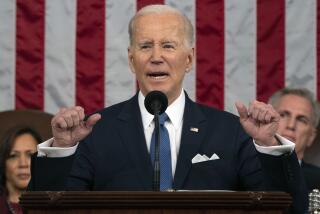Stimulus is looking less bipartisan
- Share via
WASHINGTON — President Obama, offering the first specifics on a key element in his $825-billion stimulus package, said Saturday that it would add 3,000 miles of electric transmission lines and double the nation’s use of wind and solar power within three years.
But he pressed ahead in the face of continued Republican resistance to his ideas. And some Republicans rejected Obama’s claim that he is open to their initiatives, renewing complaints that GOP proposals were being brushed aside as the administration and congressional Democrats hammered out details of the massive legislative package.
Obama used his first radio address to the nation as president to offer new specifics about how the $825 billion would be spent. The speech seemed aimed at building a broad public consensus behind a package that Obama acknowledged has generated skepticism, especially among Republicans.
He said the package was needed to lift the economy out of the most serious economic downturn since the Depression.
An “unprecedented crisis,” Obama told listeners, “calls for unprecedented action.”
As part of the administration’s continuing full-court press to maintain momentum behind the stimulus plan, both Vice President Joe Biden and the president’s senior economic advisor, Lawrence H. Summers, will appear on the network talk shows today -- an unusually heavy deployment of White House firepower.
Obama’s stimulus -- an early test of his skills in winning a major legislation victory -- is on track to pass before the congressional break in mid-February.
What remains unclear is whether it will attract significant Republican support.
In effect, the White House and congressional Republicans are engaged in the early stages of a political negotiation in which Obama seeks to pass his stimulus program with at least a plausible claim of bipartisan support. Republicans want to exert as much influence over the final package as they can without appearing to obstruct action on a problem that has stirred deep concern among millions of voters.
The president travels to Capitol Hill on Tuesday to meet with Republicans, and he discussed the plan with them at the White House on Friday. But though Republicans seem resigned to passage of the stimulus, they are complaining that the legislation moving through Congress contains none of their ideas.
The GOP is pushing especially hard for a new round of traditional tax cuts, while suggesting that the Democrats are rushing into new government spending programs that will send the deficit soaring. Democrats contend that only large-scale federal action can stabilize the economy and begin the process of recovery.
Those competing positions were reflected both in Obama’s radio speech and in GOP comments Saturday.
“On the House side they seem to be moving toward a vote on Wednesday, and unless there are some real changes in the bill, I can’t imagine there will be much, if any, Republican support,” said Kevin Smith, a spokesman for House Minority Leader John A. Boehner (R-Ohio).
Boehner gave a radio address of his own Saturday, in which he called for a stimulus plan that relies mostly on tax cuts -- “not slow-moving government spending programs.”
Boehner cast the proposal touted by Obama and Democratic leaders as fraught with wasteful spending. He cited plans to pump $6 billion into wealthy colleges and universities, set aside $600 million for the federal government to buy new cars, and lay out $50 million for the National Endowment for the Arts.
Even though the main action is in Congress, both Obama and Republicans want to mobilize voters watching at home. If Boehner wanted to stoke outrage, Obama’s strategy is to convince Americans that the stimulus would improve their lives in concrete ways.
The White House says the package, called the American Recovery and Reinvestment Plan, will modernize 10,000 schools, improving the classroom setting for 5 million children.
A centerpiece is alternative energy. Obama is proposing to reduce energy costs by weatherizing 2 million homes and 75% of all federal buildings.
The president wants the nation to generate as much renewable energy in three years as it developed in the previous 30, according to the White House. Six million homes could be powered by the new energy supplies Obama has promised.
With less than a month before the issue is decided, the prospects for bipartisan cooperation seem to be receding. At the meeting in the White House on Friday, Republican Sen. Jon Kyl (R-Ariz.) complained about one of the tax provisions in the bill, according to people who were briefed on the session.
Obama showed no willingness to budge. “I won,” he said.
Some Republicans concede that the numbers favor Obama. Democrats are solidly in control of both the House and Senate.
And as the process has rolled forward, the shape of the package has increasingly tilted toward the Democrats’ ideas. Obama initially called for 60% spending, 40% tax cuts. Folding in tax cuts was a gesture meant to woo Republicans.
Under Democratic pressure, though, Obama is now backing a plan that relies more on direct spending, less on tax cuts.
“The true test of whether this bill will get bipartisan support, as Democrats said they wanted, is whether they will incorporate any Republican ideas,” Smith said.
--
More to Read
Get the L.A. Times Politics newsletter
Deeply reported insights into legislation, politics and policy from Sacramento, Washington and beyond. In your inbox twice per week.
You may occasionally receive promotional content from the Los Angeles Times.










